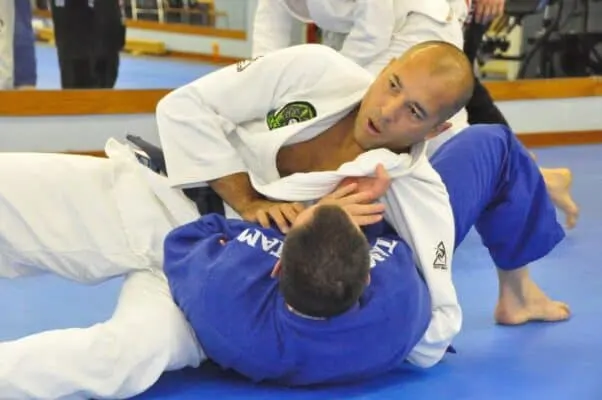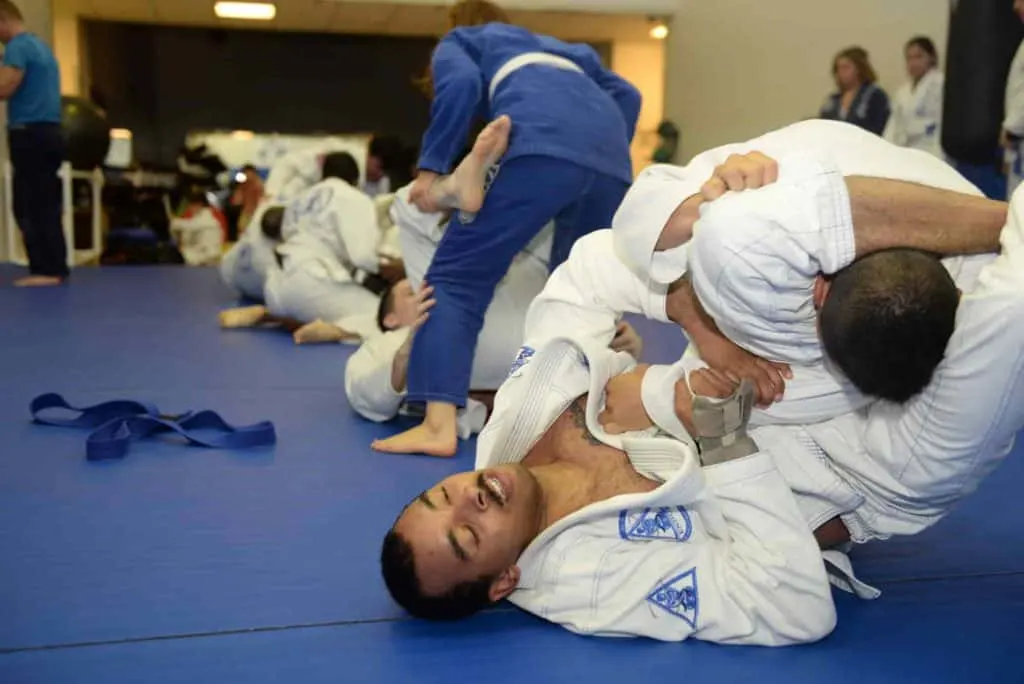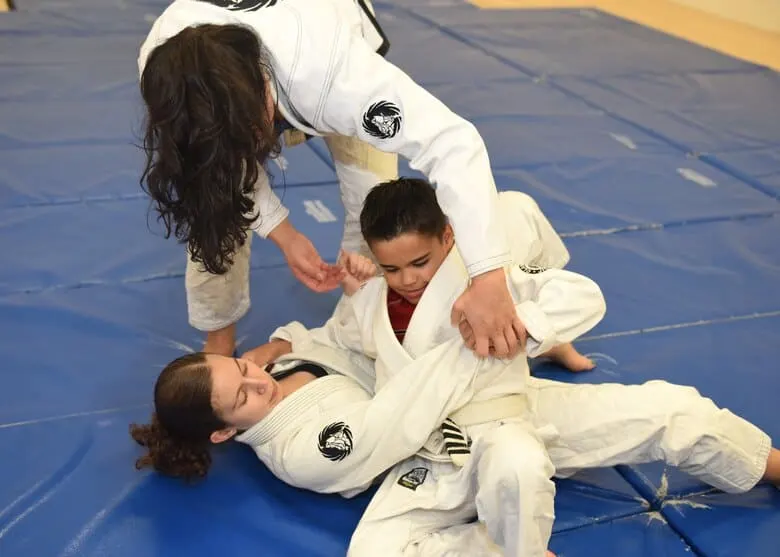
Since the early days of UFC 1, Brazilian Jiu-Jitsu(BJJ) has grown in popularity to become one of the biggest martial arts on the planet. The grappling art is sometimes compared to a human game of chess, where its users will develop knowledge of hundreds or thousands of sequences and movements ranging from transitions, joint locks to chokeholds. Much like a game of chess, deep study is required to become an expert at the art, but how difficult are the basics to learn?
Learning BJJ moves is not physically hard because BJJ is created for anyone to learn regardless of their size, strength, and athletic level. However, the total commitment that is required to become good at BJJ can be challenging for most people.
If you’re planning on taking a BJJ class for the first time, you should definitely read the rest of the article to learn why some people think BJJ is hard to learn. I will also address some of the most asked questions in regards to BJJ training.
Is Brazilian Jiu-Jitsu Hard To Learn?
When Mitsuyo Maeda, BJJ’s forefather bestowed his grappling skills upon Carlos Gracie and Luiz Franca, a huge amount of emphasis was placed upon the belief that Jiu-Jitsu was teachable to anyone. Gracie and Franca, who would become the progenitors of Brazilian Jiu-Jitsu by starting their own schools promoted this philosophy. However, despite the fact that almost anyone, regardless of their gender, age or body type can develop Jiu-Jitsu skills, the learning path a student finds themself on is undoubtedly complex.
While fundamentals can be acquired within weeks or months of taking the first class, which make a practitioner significantly more competent at defending themselves, mastering the diverse skillset requires an open mind, huge amounts of dedication and ultimately time on the mat.
Why Is BJJ Hard To Learn?
Grappling arts are unlike any other sport. While boxing and Muay Thai may have punches and other strikes which, in their most basic form, feel reasonably natural to the average person, Jiu-Jitsu often feels significantly more counterintuitive. This is in part because most of us enjoy our personal space and spending a significant amount of time with our bodies in close contact with another person takes a while to get used to. Additionally, some of the movements used in Jiu-Jitsu take a good amount of time to develop the adequate muscle memory for them to be proficient. Even the basic “shrimp”, or “hip escape” movement isn’t something the average person has got used to.
The second big barrier for people who are new to Jiu-Jitsu is that not everyone is keen to put their ego aside. Like any new skill, a newcomer will go through a period where they are bad at the art. Along with the self-judgment that they have towards themselves, they may also feel embarrassed when a more experienced practitioner submits them. As the technique is so much more important than size, speed, or strength, it is not uncommon for newcomers 100kg to be “tapped out” by opponents 30 or 40kg lighter. Even highly-athletic rugby or gridiron football players can find themselves feeling as if they are drowning on the ground against even blue, or purple belts.
RECOMMENDED FOR YOU: What is Gracie Jiu-Jitsu? Fully Explained
How Long Does It Take To Learn BJJ?

The length of time required to “learn” Brazilian Jiu-Jitsu depends on the definition of “learn”.
The average beginner practicing BJJ 2-3 times a week should theoretically become proficient enough to defend themselves from a single unarmed attacker within 4-6 months. This is not to say that they should be looking to test this theory, as with all martial arts, a practitioner should look to extricate themselves from any hostile situation before any physical action is taken.
That being said, people excel at different speeds and it goes without saying that more classes and time spent on the mat should equate to a faster rate of development.
Training consistently, the average student will be a white belt for the first year to eighteen months. This means they will know some of the techniques and submissions. They will have a low level of proficiency but will see progress.
At around this eighteen-month, to two-year mark, the student will likely on the verge of being promoted, or will have been promoted to blue belt. Blue belts tend to have undergone significant improvement and developed various techniques and submissions. They will be comfortable on the mat and will typically submit, or at least dominate white belts in sparring sessions.
After about four to five years in, the average student should theoretically be competent enough to receive a purple belt. Purple belts will be familiar with most of the techniques and submissions BJJ has to offer and are able to practice them to a decent standard. They will have identified some of the techniques they particularly excel at and will often find that these are their “go to” moves.
After seven or eight years, the student will be around brown belt level. Significantly more competent than almost all class members, the skills will have been honed through hours of drilling techniques and sparring. At this point the student may have begun training more unique and obscure attacks or transitions. Some brown belts might find themselves frustrated due to “plateauing”, but some joy can be found as they are called upon to instruct, or help lower-level students.
While it is not unheard of for some prodigies such as BJ Penn or Kit Dale to achieve black belt standard within four or five years, the average black belt takes somewhere between ten to twelve years to become a black belt. At this point, the practitioner likely lives and breathes the art, so much so they may be the instructor or head of the class. This does not mean there aren’t more techniques to learn or perfect, but the student’s arsenal of attacks, transitions and defenses is broad and well honed.
ADDITIONAL READING: BJJ Black Belt Lineage – Why It’s Important To Verify
How Often Should A Beginner Train BJJ?
To see improvements and develop muscle memory, it is recommended that a beginner should train Brazilian Jiu-Jitsu at least twice a week. Depending on their age, pre-existing injuries or health conditions and body types, training three sessions a week would be the optimal amount. This is because it takes time to prepare the body for the new stress exerted upon it. Muscles need time to recover and overdoing it greatly increases the risk of injury. It is also best to leave a day or two between training sessions to promote this recovery.
Is Jiu-Jitsu Worth The Money?
Jiu-jitsu’s value for money entirely depends on what you value. Most people value a great workout, which develops core muscles and enhances self-defense, while developing their discipline and confidence in a positive environment. If you are to ask most regular practitioners if it is worth the money, the vast majority will respond affirmatively.
Despite this, classes or memberships can be very expensive and what you can afford, or deem acceptable will be a matter of looking at your personal finances. One benefit that Jiu-Jitsu has over various other sports is that beyond the initial investment of a good gi, along with a gumshield, a good pair of shorts and a rashguard, constant equipment purchases isn’t necessary. That is unless you get addicted to collecting colorful rashguards or gis for different occasions.
Is Jiu-Jitsu Safe To Learn?
Compared to striking martial arts, the majority of contact sports and even some non-contact sports, Jiu-Jitsu is one of the safest physical pursuits anyone can take up. This is largely because it is less frenetic – barring in gyms or schools which are MMA focused, sparring doesn’t involve any strikes. This lack of strikes mean that concussions almost never happen.
While chokes can render an opponent or sparring partner unconscious, almost all BJJ practitioners will submit if they feel unable to defend themselves from their opponent’s attack. The few studies that have been conducted about the long-lasting effects of chokes suggest that long-term damage is negligible. That is to say that even if someone is rendered unconscious for as long as half a minute, they won’t have much risk of brain damage. Despite this, more studies regarding chokes and CTE need to be carried out for this to be truly confirmed. Additionally, there is some speculation about whether or not the restrictions placed on carotid arteries from chokes can lead to strokes. However, at present, there is little evidence beyond speculation which support this.
The literature linking CTE or HI-BI and repeat execution of choking techniques in MMA and grappling sports is nonexistent. This lack of evidence is especially significant given the hundreds of thousands of athletes, both past and present, who participate in choke-inclusion sports worldwide.
National Institutes of Health (NIH)
Another thing which makes BJJ safer is that weight cutting is much less common in Jiu-Jitsu competition, or at least, significantly less drastic than boxing or kickboxing. In striking arts, fighting at heavier weights will potentially increase the risk of brain damage received from being struck. More knockouts happen in heavier weight classes than lighter ones because increased weight typically leads to increased power. Again, as BJJ is much more about technique and leverage, weight, strength and power matter much less. The lack of strikes mean cutting doesn’t confer any more safety.
While deaths are incredibly rare, accidents and injuries do happen in BJJ, but they are almost always to do with ligaments, muscles, joints and bones as opposed to the head.
RECOMMENDED FOR YOU: Do MMA Fighters Get Brain Damage?
Is Jiu-Jitsu Hard On Your Body?
Whether BJJ is hard on your body depends largely on the gym you train in, the culture there, the style of rolling that is encouraged and how often you train. The more aggressive the spar, the bigger the risk of damage to joints and the back. Additionally, if you spar on your feet a lot, being taken down or thrown can have a high impact on your back, while landing at an awkward or unexpected angle can increase the risk of breaking a bone. Much like judo, throwing an opponent can put your own back, shoulders and hips under stress.
Many people spend the majority of their working day by a desk with poor posture. Sedentary lifestyles can cause a build up of tension in the hamstrings and knees, which can lead to back issues. These back issues are sometimes brought to the surface by sports such as BJJ due to the pressure put on the lumbar muscles at. Additionally various submission holds, such as “twisters”, or “bow and arrow chokes” cause the body to contort at angles which can cause a lot of stress to the spine.
Although it may seem discouraging to some, almost all practitioners of BJJ who practice for several years or more will pick up an injury of some description. Dislocated shoulders, finger issues relating to gripping on gis and knee problems are all fairly frequent occurrences in the sport. Despite these injuries, most of those who stick around will argue that the “juice is worth the squeeze”.
Tips To Avoid Getting Injured In Jiu-Jitsu
There are a number of things that are advisable if you wish to avoid injury in BJJ.
To reduce risk of damage to the joints and back, it is advisable to do mobility stretches before and after training as part of warm up and warm down routines.
If you are on the older side of things, you could consider getting a sports massage every now and then, to take stress away from the back and improve the quality of your recovery times.
Move in a controlled manner, using brute force to make up for lack of technique is dangerous not just for you, but your sparring partner. If you spar in an explosive way, you are also likely to develop a reputation for being hyper-aggressive. This will change the way your sparring partners treat you, with some choosing to avoid sparring with you as much as possible, while others will see you as an opportunity to work their own aggression out. This “fighting fire with fire” situation is likely to increase the risk of injuries significantly.
Much of injury avoidance can be chalked down to selecting the correct sparring partners. If you are a smaller person, you may want to avoid larger sparring partners as they can put a lot of pressure on your body, again particularly if they have a habit of using strength over technique. Newcomers to class are also more likely to cause injuries than experienced users. This is in part because they aren’t comfortable with the body-to-body contact, or the feeling of being trapped or restricted will cause them to move aggressively or chaotically, moving in a way that isn’t far removed from striking.
Another suggestion, which may be less favorable to some is that you spend as little time as you can starting from the standing position. As mentioned previously, both falling and throwing put a lot of pressure on your hips, shoulders, knees and back. While takedowns and throws are incredibly useful in both competition and street situations, you have to be prepared for accidents to occur as part of the training. Working on break falls can prepare you for landing on the ground better, but they are no guarantee.
For fingers, it is advisable to get finger tape and learn how to apply it. This may reduce both risk of immediate injury and arthritis.
Tap early and tap often. Do not let ego or machismo keep you from submitting when your body is under immense pressure and relief from that pressure will mean that you prevent yourself from a slipped disk, pulled muscle, or damaged ligament.
Can You Learn BJJ On Your Own?
Without a partner to try movements out or spar with, it’s almost impossible to learn BJJ. While the internet is stacked with great instructional videos, which can help you expand your knowledge, or give you an arsenal of new “weapons” to try out in an actual gym, without an experienced instructor to give you advice, or the “pressure testing” of rolling, it’s very difficult to build muscle memory and develop efficiency.
Grappling dummies and other tools can help you drill and develop some of the mechanics of the individual movements, but these practices only provide any real benefit to someone once they have been training in a gym for an extended period of time. It is arguably better that you spend time developing flexibility, core strength and endurance, so that your body and mind are more open to the knowledge imparted in classes.
What Age To Start Jiu-Jitsu For Kids?

While coaches vary from opinion on this matter, most of them seem to agree that when a child is 5 years old they are likely to have a positive experience from starting to practice BJJ. While some would go as young as four, the ideal starting age for BJJ is largely linked to how socially mature the child is. If they are bathroom trained, have the attention span to sit through an hour or more of a teacher giving instruction, along with the communication skills required to verbalize their needs and wants, they can stand to benefit from BJJ.
Practicing BJJ will typically instill a sense of discipline in the student as well. That is not to say that you should dump an unruly child onto an instructor already handling a large group of kids, but usually the respect they develop for teachers and other classmates can be a transferrable virtue which will make them more teachable outside of the gym. Beyond the discipline, there are a huge number of benefits the child might find, including increased cardiovascular health, confidence and longstanding friendships. As long as you aren’t an overly pushy parent, hoping your child becomes the next Rickson Gracie or Craig Jones, the outcome will almost always be positive.
RECOMMENDED FOR YOU: Top 3 Best Martial Arts For Kids – A Basic Guide For Parents
Final Thoughts
The journey of a BJJ student can be a bumpy road. Whether from bumps in confidence or ego due to the sometimes incredibly steep learning curve, or bumps to the body, it can be anything but smooth sailing. The vast majority of those who have been training for several years, or who have trained in the past will recommend it. Sometimes we can all stand to benefit from being humbled and a mind activated by the desire to learn an incredibly efficient, well-respected martial art can give us a new outlook on life. If you are willing to take the risk, BJJ can give you immense joy and a huge range of other benefits.
